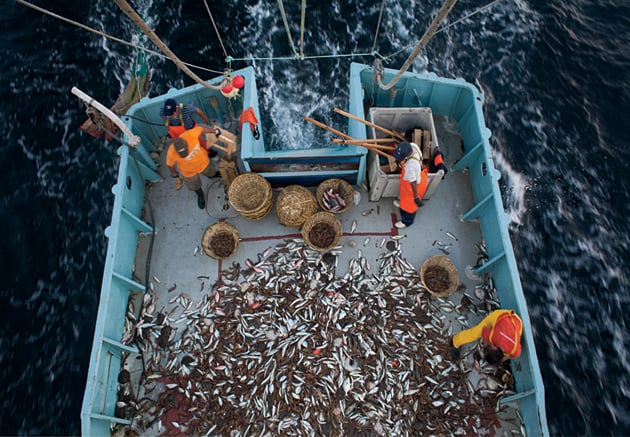Four Steps Toward Guilt-free Seafood
What can we do to address the collapsing global fishery?
Over the past month, I’ve received many responses from friends and on social media to my Harper’s Magazine story, reported with photographer Dominic Bracco II, on the decline of the fishery in the Sea of Cortez. As I skim through them, two sentiments stand out: “Great, one more thing I have to worry about eating,” and “I guess I should never eat fish again.”
My response to the first concern is simple: the fishing crisis is the most important global issue related to your dinner table, and you should worry about it. Debates over genetically modified beef, organic veggies, and free-range chicken pale next to the nightmarish state of our seas.
As for the second concern, Dominic and I didn’t spend two months wandering through fishing towns in order to persuade readers to give up fish. I understand the impulse — I myself wonder sometimes if it’s worth it. But if everyone who cared about the oceans stopped eating fish, the only people eating fish would be people who don’t care about the oceans.
[*] For a crash course in fish nerdery, read these recommendations from the Monterey Bay Aquarium’s Seafood Watch program.
Few of us have the time or energy to become fish nerds — the sort of people who demand to know before they eat whether a swordfish was long-lined or spear-caught (spear-caught, please), or whether a salmon came from Alaska or Oregon (Alaska, no question).[*] Industry insiders like to say that most seafood is eaten in restaurants; to the extent that that’s true, those who care about sourcing have a unique opportunity to shift the market. And in turn, the restaurant industry — and the market as a whole — must adjust to meet new demand.
The good news is that much of the problem is economic rather than ecological. I believe that our oceans can support our growing appetite for healthy seafood if we can learn as a society to distribute and consume it more wisely. There are four steps we need to take before we can have guilt-free seafood:
1. Build the market for ethical seafood.
Several (flawed, but indicative) surveys have suggested that well over half of consumers would prefer to eat sustainably caught fish, and would be willing to pay more to do so. If you’re one of these people, bring it up at your favorite restaurants. Most industry workers will assume that sustainable options aren’t important to customers; if an establishment doesn’t have any, tell the waiter to tell the chef what you want. Then order the chicken and say you expect sustainable fish next time. (I do this even when I want the chicken anyway.) The restaurant and seafood industries are both hypercompetitive, and businesses are always looking for a market advantage.
2. Fix the supply chain.
For our Harper’s story, Dominic and I spoke with “Pioline,” a dive fisherman, and watched him hunt for the shellfish callo. His favorite time of year, he told us, is octopus season, when he dives down and painstakingly catches octopuses in nooks and crannies below the surface. When he returns to the surface, though, he has to sell them for the same price as the ones other fishermen catch in destructive trawl nets. Meanwhile Kristopher Lofgren, the owner of the super-sustainable restaurant Bamboo Sushi in Portland, told me the one product he can’t source ethically is octopus. There are many, many middlemen in the seafood industry — the shrimp Dominic and I saw harvested in the Sea of Cortez changes hands as often as six times before anyone eats it. This is 2013: even indigenous Seri fishermen are on Facebook. Please, someone, reinvent the supply chain.
3. Improve enforcement standards.
As it stands, far too many restaurants claiming to offer “sustainable” food are simply lying to diners. The word has no legal basis in the United States, so it costs nothing for restaurants to drape themselves in the sustainable mantle. The creation of genuine standards could start with bigger players like the National Oceanic and Atmospheric Administration, which has expressed some interest in enforcing claims of sustainability. Another option would be an organization that rates seafood in restaurants by sustainability — just not the Marine Stewardship Council, an industry body that certifies sustainable fisheries (but that NPR and others have uncovered is not nearly up to the task). Perhaps we could try a LEED-style system, which awards platinum, gold, and silver grades to restaurants. Or perhaps Michelin-style stars — nothing freaks out a restaurant like the prospect of losing a Michelin star.
4. Accept surprise.
Perhaps the biggest underlying cause of the global fisheries crisis is that most of us are demanding and picky eaters. Around 60 percent of the seafood consumed in the United States, for instance, is shrimp, salmon, and tuna (in that order). The American taste for these creatures has helped make them among the most unsustainable seafood options, because they’re being overfished. Restaurants that source good sustainable fish will not always be able to provide exactly what we want. It’s impossible to guarantee volume without relying on bad practices, especially in winter. So when a waiter says there’s no more salmon, don’t have a fit and give the restaurant an excuse to buy farmed Atlantic salmon. Close the menu and say, “Surprise me.”



